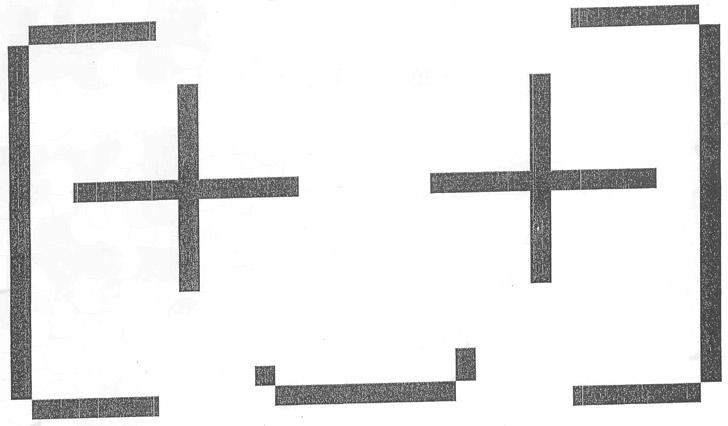Digital Discipline: Minimalism in House and Techno. III
Published in Christoph Cox and Daniel Warner, Audio Culture: Readings In Modern Music, 2004
the profoundly thinned-out tracks highlighted on Mille Plateaux’s Clicks + Cuts compilations, or Jan Jelinek’s densely looped work as Farben, which he explicitly connects to the minimalist tradition via the moir=8E effects in Op Art – could hardly be classified as club music, lacking the forceful rhythmic intensity required to sustain a dance floor. If anything, the latter exists as music in reaction to the dance club, an avant-gardist rejection of the obviousness that characterizes most populist dance music.
Mille Plateaux – Clicks & Cuts (2000)
Mille Plateaux – Clicks & Cuts 2 (2001)
Mille Plateaux – Clicks & Cuts 4 (2004)
![]()
In minimalism’s ubiquity, then, its strategies have turned out to offer solutions to varying, even opposed, sets of problems. If one thing remains constant, though, it’s the emphasis on time – by cutting out pop music’s chord progressions and four-bar structure, and emphasizing gradually evolving rhythmic cycles,
It’s worth asking why non-club-oriented productions have retained this focus. The ideology of the nightclub, of course, is that “the party never ends.” This is preserved by seamlessly sequencing multiple DJs across the course of the evening who will typically play within well-defined stylistic and tempo parameters; it’s augmented by the use of drugs like Ecstasy to help keep partiers going long after normal bedtimes.
It’s possible that this represents a resurgence of the Modernist ideal of pure formalism – related, of course, to classical Minimalism’s exploration in the acoustic and psychological properties of repetition. Just as Picasso could exhibit the African mask divorced from its social context as an example of “pure” geometry, domestic techno seems to pursue ever more specific lines of inquiry into the function of
Consider, for instance, Thomas Brinkmann’s X100 LP, which is built of nothing more than click, tone pulse, and a single bass drum, each element doubled and sent cycling out of phase. Sonically, the record seems like an experiment in phasing – an experiment that creates a profoundly disorienting listening experience, given the way doubled sounds bounce from speaker to speaker, as though the stereo field had been turned into a hall of funhouse mirrors. But the recordings’ mathematical underpinnings underscore a more clinical interest. Brinkmann calculated the precise number of beats he would need in order for the LP, spinning at 33 RPM, to contain exactly two more bass kicks in one channel than in the other, with the express interest of creating a record whose grooves, on inspection, would yield the unusual image of a pair of overlapping circles. Given Brinkmann’s visual emphasis, combined with his mathematical investigations,
– including the visual output, as raster lines, created by audio signals when routed through video channels. Likewise, his visual works – including a series of paintings based on the idea of the loop – thrum with dots and miniscule lines recalling Martin, while his Spartan, scientifically-oriented sculptures and installations suggest Donald Judd’s clinical influence.
It’s certainly not limited to the world of house and techno; if anything, it may still be on the ascendant in pop music. For instance, the Clipse’s 2002 tune “Grindin’,” produced by The Neptunes, is perhaps the most minimalist track yet to come out of hip hop, itself a genre founded on the surgical strategy of isolating short rhythmic breaks and adding repeating horn stabs or keyboard lines for tone color and intertextual significance. “Grindin'” features a mere handful of percussive sounds, all curiously deadened, to which it adds crystal-clear finger snaps and the swooping, falsetto chorus of “Grindin’,” repeated ad nauseum.
House and techno, in contrast, generally devoid of vocals save for the odd sample or refrain, have gone minimal as a means of drawing ever closer to the beat itself, and to the idealized structure that Eshun identifies as the “rhythmachine.”
varying from Chain Reaction’s well-known ambient dub-techno (dubbed “heroin house” by Reynolds, for its dreamy, horizontal inclinations) to Surgeon’s punishing, tribal loopism. Detroit’s Jeff Mills is often tagged as a minimalist, despite the fact that his DJ sessions, constructing dangerously top-heavy piles of loops upon loops upon loops – are sonically speaking far more massive than most pop music. Of course, the same could be said as well of early minimalism. As classic
Then again, Steve Reich continued to be branded as a minimalist long after he’d left behind the experiments in pulse and phasing that led Michael Nyman to coin the term in the first place.
(to be continued)
Posted in academia on October 5th, 2008 by fresh good minimal | 3 Comments








 gmail
gmail com
com
